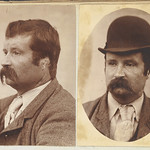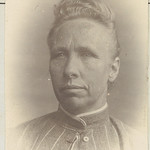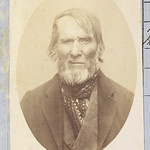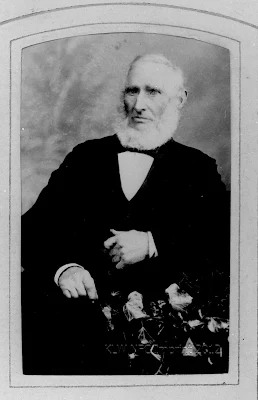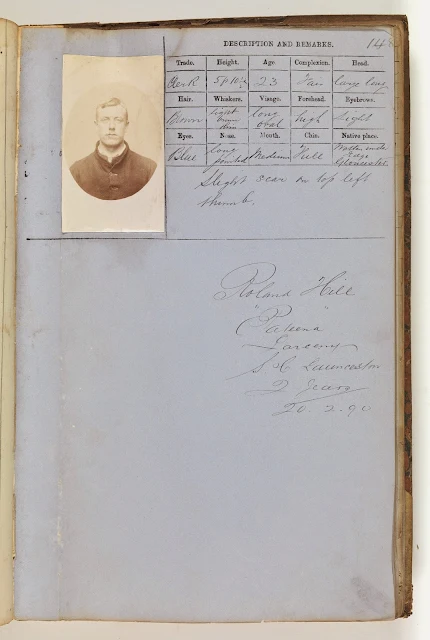Online until recently, the Archives Office of Tasmania digitized and displayed 92 copies of the carte-de-visite photographs of Tasmanian convicts held at the Queen Victoria Museum and Art Gallery, originals of which which were exhibited at the QVMAG in the 1970s as the work of Thomas J. Nevin.
Webshots show the online records were captioned "Photograph taken at Port Arthur by Thomas Nevin" (see the complete list here) and some were dated 1874 or earlier. In fact, few were taken at Port Arthur, and many were taken over a period of years in the 1870s-1880s. The date and place of the AOT caption reflects the error about Port Arthur as the place where all of these photographs were taken, made by an archivist in the early 1900s, probably by Edward Searle while working in John Watt Beattie at his museum and studio in Hobart between 1911-1916 where three panels of forty prisoner mugshots were offered for sale, among other convict memorabilia. Similarly, the date "1874" does not reflect actual judicial events in the prisoner's criminal career, i.e. whether he was photographed on sentencing, incarceration or discharge. The photographer attribution to Thomas J. Nevin, however, was and still is correct.
The majority - but not all - of the collection of Tasmanian prisoner photographs taken in the 1870s held at the Archives Office of Tasmania are black and white paper copies reproduced ca. 1985 from original cdvs held in the collection at the Queen Victoria Museum and Art Gallery.
TAHO Commons Collection at Flickr
Tasmanian convict + prison photos, a set by Tasmanian Archive and Heritage Office on Flickr (Commons).
See the article on this site about the photograph of prisoner Hugh Cohen and another of Cohen by Nevin at the Mitchell Library SLNSW. The majority of mugshots in this collection were taken from the 1890s to the early 1900s. Some show the same prisoner photographed by Nevin in the 1870s but as a much older re-offender, eg. James Geary, originally photographed in 1874 and again in 1889. In addition to this selection of gaol mugshots on prisoner records , the Tasmanian Archive and Heritage Office holds over 90 copies and originals of Nevin's prisoner portraits, tagged at the National Library of Australia's Trove service.
Estrays at TAHO with APA citation
Recent 1870s originals uploaded by TAHO (improvements on the black and white copies from the Queen Victoria Museum and Art Gallery) are these, with TAHO's original APA citations:

LINC Tasmania APA citation: "Alfred Doran, probably Albert Dorman, convict transported per Blenheim.
Photograph taken at Port Arthur by Thomas Nevin."

LINC Tasmania APA citation: "George Growsett, convict transported per Lady Montague.
Photograph taken at Port Arthur by Thomas Nevin."
Read more about this prisoner here: Prisoner George GROWSETT 1860 and 1873

LINC Tasmania APA citation: "James Harrison, convict transported per Rodney.
Photograph taken at Port Arthur by Thomas Nevin."
Read more about this prisoner here: Prisoner James HARRISON

Henry Smith - but unidentified by TAHO
LINC Tasmania APA citation: "Convict, transported per Rodney.
Photograph taken at Port Arthur by Thomas Nevin."
Read more about this prisoner here: How misattribution can persist

LINC Tasmania APA citation: "James Smith, Convict transported per John Calvin.
Photograph taken at Port Arthur by Thomas Nevin."

LINC Tasmania APA citation: "Robert West, convict transported per Gilmore.
Photograph taken at Port Arthur by Thomas Nevin."

LINC Tasmania APA citation: "William Ryan, arrived free per City of Hobart, tried Launceston 1868.
Photograph taken at Port Arthur by Thomas Nevin."
Read more about this prisoner here: Prisoner William RYAN wholesale forger at the TMAG

LINC Tasmania APA citation: "Richard Phillips, convict transported per Atlas.
Photograph taken at Port Arthur by Thomas Nevin."
Read more about this prisoner here: Prisoner Richard PHILLIPS 1874
RELATED POSTS main weblog
- George Leathley, No. 226
- Archives Office of Tasmania records of Nevin’s convict portraits
- Port Arthur convict with headrest
- Bewley Tuck can speak for himself
- Aliases, Copies, and Misattribution
- Convict carte No. 1: George White aka Nutt
- Thomas Nevin's hand-coloured convict photographs
- Two mugshots of Hugh Cohen/Cowen/Cowan 1878
- Mugshots of James Geary 1874 and 1889
- Mugshots removed: Thomas Reilly/Riley
- Prisoner mugshots by Constable John Nevin to 1890
- Poster boys 1870s
- Aliases, Copies and Misattribution
- Julia Clark: A Question of Stupidity and the NLA
- Edwin Barnard at the NLA with Nevin's convict photographs



